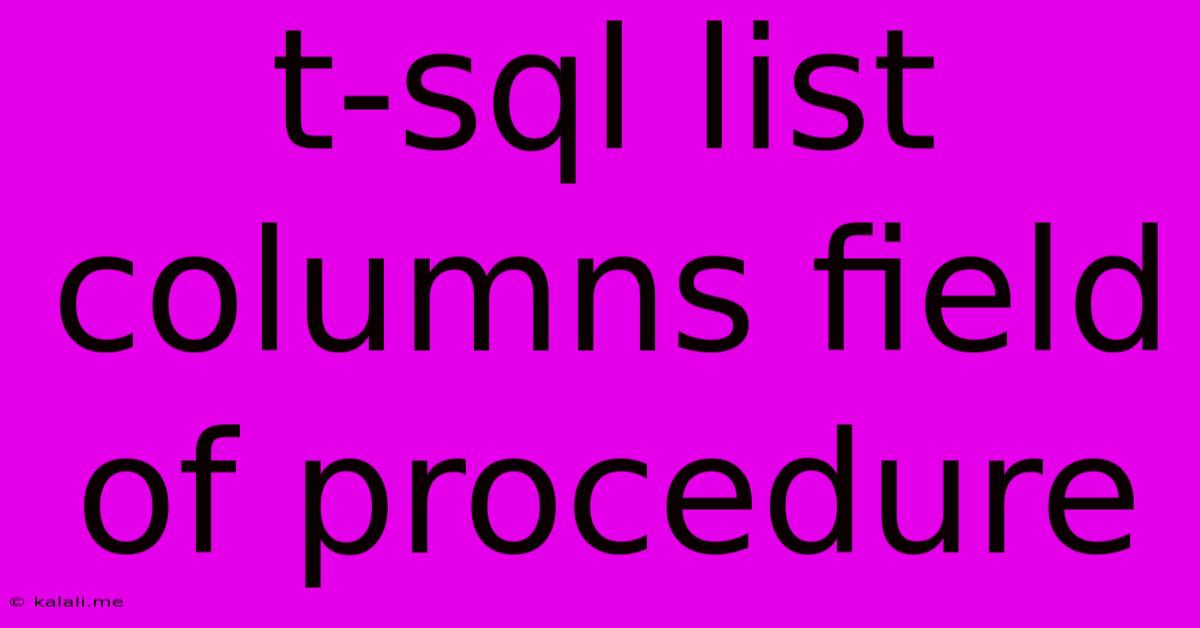T-sql List Columns Field Of Procedure
Kalali
May 24, 2025 · 3 min read

Table of Contents
Listing Columns Returned by a T-SQL Stored Procedure
This article will guide you through several methods to effectively list the columns returned by a T-SQL stored procedure. Understanding the output structure of your stored procedures is crucial for database development, integration with other systems, and efficient data manipulation. This knowledge is vital for tasks like generating reports, building APIs, or troubleshooting data inconsistencies. We'll cover different approaches, from using sp_help to more advanced techniques, suitable for various scenarios and skill levels.
Understanding the Need:
Before diving into the methods, let's understand why listing the columns returned by a stored procedure is important. Knowing the column names and data types allows you to:
- Efficiently process results: You can dynamically adapt your application code to handle the returned data without hardcoding column names, making your application more robust and maintainable.
- Debug and troubleshoot: Inspecting the output schema helps identify errors in data retrieval or transformations within the stored procedure.
- Database documentation: Automatically generating documentation about your stored procedures, including the returned columns, improves collaboration and understanding within your team.
- Data integration: Accurately mapping columns is essential when integrating your database with other systems or applications.
Methods for Listing Columns:
Here are several techniques to achieve this, ranging from simple to more complex approaches:
1. Using sp_help (Simple Approach):
The simplest method is using the built-in system stored procedure sp_help. This provides a general overview of the stored procedure, including its parameters and, importantly, the columns it returns if it's a SELECT statement.
sp_help 'YourStoredProcedureName'
Replace 'YourStoredProcedureName' with the actual name of your stored procedure. The output will be a comprehensive description of the procedure, with a section detailing the column names and data types if the procedure returns a result set. This method is quick and easy for basic checks.
2. Executing the Procedure and Inspecting Results (Dynamic Approach):
This method involves executing the stored procedure and then programmatically examining the returned result set's metadata. This requires using a programming language like C#, Java, or Python, interacting with your SQL Server instance. This approach offers flexibility and is useful when you need to handle the metadata dynamically within your application.
3. Using SQL Server Management Studio (SSMS) (Visual Approach):
SSMS provides a visual way to inspect the output of your stored procedures. After executing the procedure, you can view the results in a grid. The top row shows the column names, providing a quick visual reference. This method is ideal for quick checks and understanding the structure visually.
4. Analyzing the Procedure's Code (Direct Approach):
For complex stored procedures, examining the T-SQL code directly is sometimes necessary. Look for SELECT statements within the procedure; the columns selected will be the columns returned. This is essential for understanding the logic and identifying potential issues. However, this can be time-consuming for large or complex procedures.
Choosing the Right Method:
The best method depends on your specific needs and context. For simple procedures, sp_help is usually sufficient. For dynamic applications or detailed analysis, programmatic inspection of the result set is more appropriate. Using SSMS is convenient for quick visual verification. Directly analyzing the procedure's code should be reserved for cases where other methods are insufficient or when deeper understanding of the procedure's logic is necessary.
Beyond Column Names:
Remember to consider not only the column names but also their data types and nullability when integrating with external systems or applications. This information is crucial for avoiding data type mismatch errors and handling null values appropriately.
By mastering these techniques, you can effectively manage and understand the output of your T-SQL stored procedures, leading to more efficient and robust database applications. Remember to always prioritize clear, well-documented code to ensure long-term maintainability and collaboration.
Latest Posts
Latest Posts
-
What Is 1 5 Of A Tablespoon
Jun 30, 2025
-
How Long Does It Take To Drive Through Illinois
Jun 30, 2025
-
If I Was Born In 1988 How Old Am I
Jun 30, 2025
-
How Much Is 800 Grams Of Chicken
Jun 30, 2025
-
How Long Will It Take To Walk 20 Miles
Jun 30, 2025
Related Post
Thank you for visiting our website which covers about T-sql List Columns Field Of Procedure . We hope the information provided has been useful to you. Feel free to contact us if you have any questions or need further assistance. See you next time and don't miss to bookmark.